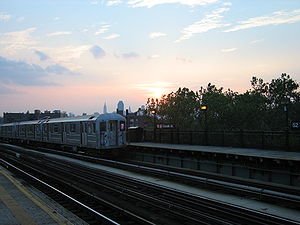52nd Street station (IRT Flushing Line)
52 Street | |||||||
|---|---|---|---|---|---|---|---|
 | |||||||
| Station statistics | |||||||
| Address | 52nd Street & Roosevelt Avenue Woodside, NY 11377 | ||||||
| Borough | Queens | ||||||
| Locale | Woodside | ||||||
| Coordinates | 40°44′38.53″N 73°54′46.31″W / 40.7440361°N 73.9128639°W | ||||||
| Division | A (IRT)[1] | ||||||
| Line | IRT Flushing Line | ||||||
| Services | 7 | ||||||
| Transit | |||||||
| Structure | Elevated | ||||||
| Platforms | 2 side platforms | ||||||
| Tracks | 3 | ||||||
| Other information | |||||||
| Opened | April 21, 1917 | ||||||
| Opposite- direction transfer | Yes | ||||||
| Former/other names | 52nd Street–Lincoln Avenue | ||||||
| Traffic | |||||||
| 2023 | 1,402,690[2] | ||||||
| Rank | 224 out of 423[2] | ||||||
| Station succession | |||||||
| Next north | Template:NYCS next | ||||||
| Next south | Template:NYCS next | ||||||
| |||||||
| |||||||
| |||||||
52nd Street (also known as 52nd Street–Lincoln Avenue) is a local station on the IRT Flushing Line of the New York City Subway. Located at the intersection of 52nd Street and Roosevelt Avenue in Woodside, Queens, it is served by the 7 train at all times.
History
The Flushing Line was opened from Queensboro Plaza to Alburtis Avenue (now 103rd Street–Corona Plaza) on April 21, 1917, with a local station at 52nd Street.[4]
The platforms at 52nd Street were extended in 1955–1956 to accommodate 11-car trains.[5]
As part of the 2015–2019 Capital Program, the MTA would renovate the 52nd, 61st, 69th, 82nd, 103rd and 111th Streets stations, a project that has been delayed for several years but is slated to begin in mid-2020. Conditions at these stations were among the worst of all stations in the subway system.[6]
Station layout
| Platform level | ||
| Side platform | ||
| Southbound local | ← | |
| Peak-direction express | ← | |
| Northbound local | | |
| Side platform | ||
| Mezzanine | Fare control, station agent, MetroCard and OMNY machines | |
| Ground | Street level | Entrances/exits |

This elevated station has two side platforms and three tracks. The center express track is used by the rush hour peak direction <7> express train. Both platforms have beige windscreens and brown canopies with green roofs along the entire length except for a small section at the south end, which has only a windscreen on the eastbound side and a waist-high steel fence on the westbound side.[7][8]
This is the southernmost (geographical west) station on the IRT Flushing Line that is on a steel viaduct above Roosevelt Avenue. West of this station, the line curves and becomes a concrete viaduct above Queens Boulevard until 32nd Place.
Exits
This station has two entrances. The full-time one is a wooden elevated station house beneath the tracks at the south end. It has a single staircase to each platform, waiting area that allows free transfer between directions, turnstile bank, token booth, and two staircases to the street, one to each western corner of 52nd Street and Roosevelt Avenue.[7][8]
The other entrance is at the station's extreme north (geographical east) end. A single canopied staircase from each platform goes down a landing outside of a now-closed elevated station house beneath the tracks. A single HEET turnstile provides entrance/exit from the station before a street stair goes down 53rd Street and Roosevelt Avenue. The Manhattan-bound staircase is at the northeast corner while the Flushing-bound one is at the southeast corner.[7][8]
References
- ^ "Glossary". Second Avenue Subway Supplemental Draft Environmental Impact Statement (SDEIS) (PDF). Vol. 1. Metropolitan Transportation Authority. March 4, 2003. pp. 1–2. Archived from the original (PDF) on February 26, 2021. Retrieved January 1, 2021.
- ^ a b "Annual Subway Ridership (2018–2023)". Metropolitan Transportation Authority. 2023. Retrieved April 20, 2024.
- ^ "Annual Subway Ridership (2018–2023)". Metropolitan Transportation Authority. 2023. Retrieved April 20, 2024.
- ^ "Transit Service on Corona Extension of Dual Subway System Opened to the Public". The New York Times. April 22, 1917. p. RE1. Retrieved October 2, 2011.
- ^ Authority, New York City Transit (1955). Minutes and Proceedings.
- ^ "MTA To Overhaul Six Stations on the 7 Line, Currently in Design Phase". Sunnyside Post. November 19, 2019. Retrieved April 29, 2020.
- ^ a b c "www.nycsubway.org: IRT Flushing Line". www.nycsubway.org. Retrieved February 28, 2016.
- ^ a b c Cox, Jeremiah. "52 Street-Lincoln Av (7) - The SubwayNut". www.subwaynut.com. Retrieved February 28, 2016.




